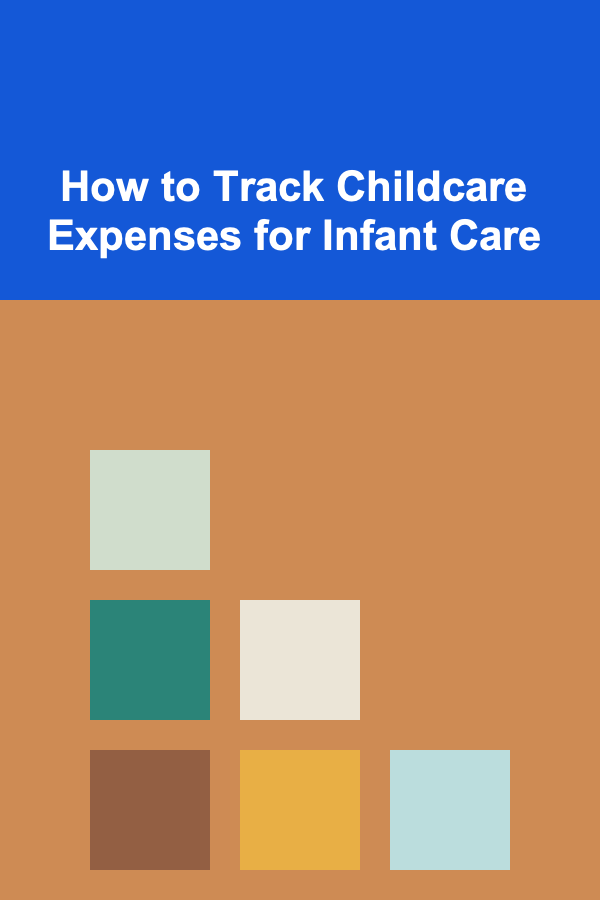
How to Track Childcare Expenses for Infant Care
ebook include PDF & Audio bundle (Micro Guide)
$12.99$5.99
Limited Time Offer! Order within the next:

Raising an infant comes with a multitude of joys and challenges, and one of the significant challenges for many families is managing the financial aspect of childcare. Infant care can be expensive, especially as it includes a variety of costs such as daycare services, health-related expenses, food, and other miscellaneous needs that grow over time. Tracking childcare expenses carefully is essential to maintain financial stability and avoid unexpected costs. In this article, we will explore effective methods for tracking and managing these expenses, including budgeting, record-keeping, and understanding tax benefits.
The Importance of Tracking Childcare Expenses
Tracking childcare expenses is essential for several reasons:
- Budgeting and Financial Planning: Understanding your childcare costs helps you to plan your monthly or yearly budget. Infants, especially in the early years, have many associated costs that can be difficult to manage if you don't keep track of them.
- Tax Benefits and Deductions: The IRS allows parents to claim deductions or credits for childcare costs, which can help reduce your tax burden. But in order to claim these benefits, you must keep detailed records of your expenses.
- Cost Reduction: By monitoring your spending, you can spot unnecessary or avoidable costs and make adjustments to reduce overall childcare expenses.
- Financial Transparency: If both parents are contributing to the household finances or if you're working with a caregiver, keeping accurate records promotes transparency and ensures everyone is on the same page about expenses.
Types of Childcare Expenses
Childcare expenses for infants can vary greatly depending on your situation, location, and choice of care. Below are the most common types of expenses families face:
1. Daycare and Babysitting Costs
One of the largest childcare expenses is daycare or babysitting services. Whether you choose a licensed daycare, a nanny, or a family member to provide care, it's essential to keep track of all related expenses.
- Daycare: Licensed daycare facilities often charge monthly or weekly rates, which may include additional fees for extended hours, meals, or special programs.
- Nanny: A nanny is usually hired for in-home care and might charge a weekly or hourly rate. Some nannies also offer additional services such as light housekeeping or tutoring, which could add to the overall cost.
- Babysitting: For occasional care, many families hire a babysitter. Keep track of the hourly rate, the number of hours worked, and any additional expenses, such as transportation or meals.
2. Health and Medical Costs
Infants require frequent visits to the doctor, including regular check-ups and vaccinations. These health-related costs can add up, especially if the baby experiences health issues or requires special care.
- Doctor Visits: Regular check-ups, sick visits, and vaccinations all incur costs. These may be covered by insurance, but copays or deductibles may still apply.
- Medications: Prescription medications or over-the-counter treatments for minor illnesses or conditions can add to your expenses.
- Special Care or Therapies: If your baby requires physical therapy or other specialized care, these costs should be carefully tracked as they may be significant.
3. Infant Supplies
Babies require a range of supplies, some of which can be surprisingly expensive. Tracking the cost of these items can help you stay on budget and avoid overspending.
- Diapers and Wipes: This is one of the largest ongoing expenses for parents. Tracking the number of diapers you purchase and their cost can help you identify potential savings by buying in bulk or switching to a more affordable brand.
- Formula and Baby Food: If you are formula feeding, this expense can quickly add up. Track the number of cans or bottles purchased and any additional costs related to feeding.
- Clothing and Gear: Babies grow quickly, so parents are constantly purchasing new clothing and baby gear. This includes clothes, strollers, cribs, car seats, and other essential items.
- Toys and Books: While these may not be essential, many parents choose to buy educational toys and books for their infant. Tracking this expense can help prevent overspending on items that might not be necessary.
4. Transportation Costs
Transportation costs can be significant when it comes to childcare. If you are driving your child to daycare or appointments, it's essential to track related expenses.
- Fuel: The cost of gasoline for trips to daycare, doctor's offices, or other necessary locations can add up. Keep a record of the distance and frequency of these trips.
- Parking: If you are driving to a daycare center or medical facility, parking fees may apply. Keep track of these costs, as they can add up over time.
- Car Maintenance: Regular trips to daycare or other locations may lead to higher wear and tear on your car, which can result in increased maintenance or repair costs. Track any maintenance work that may be directly related to these childcare transportation needs.
5. Miscellaneous Costs
There are many other small, but significant, expenses associated with infant care. These include:
- Parenting Classes: Some parents invest in parenting classes to learn more about infant care or prepare for future stages of development.
- Baby Sitters or Emergency Care: As your baby grows, you might occasionally need someone to care for your child during an emergency or to allow you time to run errands or take care of personal matters.
- Baby Proofing Your Home: Items like outlet covers, baby gates, and furniture anchors are necessary to keep your home safe. Keep track of these one-time costs, especially as you make changes to your home to accommodate a growing child.
Tools for Tracking Childcare Expenses
Now that we've covered the types of expenses you'll encounter, it's important to understand the best methods for tracking these costs. Fortunately, there are many tools and strategies available for parents to stay on top of their childcare spending.
1. Spreadsheets
One of the simplest and most customizable methods for tracking childcare expenses is using a spreadsheet. Programs like Microsoft Excel or Google Sheets allow you to create categories for each type of expense, input amounts, and track totals over time.
- How to Organize: Create separate columns for different categories (daycare, medical costs, supplies, etc.). Add rows for each individual expense and input the amount spent. You can also create a running total at the bottom to track your cumulative expenses.
- Benefits: Spreadsheets are flexible and easy to update, allowing you to add or remove categories as your needs change. They also allow you to easily sort data and calculate totals or averages.
2. Expense Tracking Apps
There are many apps designed to help individuals track expenses. Some of the most popular finance apps, such as Mint, YNAB (You Need A Budget), or PocketGuard, can be used to track childcare costs.
- How to Use: Input your childcare-related expenses as they occur, and assign them to relevant categories within the app. Some apps will allow you to set up recurring expenses, which can be particularly useful for ongoing costs like daycare payments or medical bills.
- Benefits: These apps can help automate the tracking process and provide insights into your spending habits. Many apps can also connect to your bank account, making it easier to record expenses as they are incurred.
3. Receipts and Paper Records
Some parents prefer to track their expenses manually by keeping receipts or writing down expenses on paper.
- How to Organize: Keep a folder or binder to store receipts related to childcare expenses. Use dividers or labels to organize them by category (e.g., medical, daycare, supplies).
- Benefits: This method can be useful for people who prefer a more tactile approach to record-keeping. It's also beneficial if you need to keep physical copies of receipts for tax purposes.
4. Dedicated Childcare Expense Journals
For those who prefer something more specific than general financial apps, there are specialized childcare expense journals available. These journals are designed to track expenses related to the care of children, offering pre-made sections for categories like daycare, medical, and supplies.
- How to Use: Use a journal to manually input each expense as it occurs. These journals may also provide a space for notes or reminders regarding due dates for payments or upcoming medical visits.
- Benefits: The benefit of a dedicated childcare expense journal is that it is easy to use and tailored specifically for parents, making it simpler to track all aspects of infant care in one place.
Tax Benefits for Childcare Expenses
In addition to simply tracking expenses, it's also important to understand how these expenses can benefit you during tax season.
1. Child and Dependent Care Tax Credit
The IRS provides a tax credit for parents who pay for childcare services. The amount you can claim depends on your income and the number of children in care. To be eligible for this credit, the care must be provided to allow you (and your spouse, if applicable) to work or look for work.
- How to Claim: You must keep accurate records of the childcare expenses throughout the year, including receipts and invoices from daycare providers, babysitters, or nannies.
- Amount: The credit can be up to 35% of your eligible expenses, with a maximum of $3,000 for one child or $6,000 for two or more children. The percentage decreases as your income increases.
2. Flexible Spending Accounts (FSAs)
Some employers offer Flexible Spending Accounts (FSAs) for dependent care, allowing you to set aside pre-tax income to cover childcare expenses. This reduces your taxable income, potentially lowering your tax liability.
- How to Use: Sign up for a dependent care FSA through your employer and use the funds to pay for eligible childcare costs. Keep track of the amount you contribute and the expenses you claim throughout the year.
- Limitations: The maximum contribution limit for dependent care FSAs is generally $5,000 per year for individuals or married couples filing jointly ($2,500 if married and filing separately).
Conclusion
Tracking childcare expenses for infant care is essential for both financial planning and maximizing potential tax benefits. By understanding the various costs associated with childcare and using the right tools to track them, parents can better manage their finances and ensure they are prepared for the financial demands of raising an infant. Whether using spreadsheets, apps, or paper records, keeping a detailed log of all expenses helps create a clear financial picture and aids in budgeting for both the short and long term. Additionally, understanding available tax benefits can reduce your overall childcare costs, making it easier to navigate the financial challenges of raising a child.
Reading More From Our Other Websites
- [Skydiving Tip 101] Thrills You'll Experience on Your First Fun Skyjump
- [Personal Care Tips 101] How to Apply Sunscreen to Prevent Skin Cancer
- [Personal Financial Planning 101] How to Use Automated Investing Tools: A Comparison of Robo-Advisors and Best Online Brokers
- [Home Holiday Decoration 101] How to Decorate Your Staircase for the Holidays with Style
- [Personal Financial Planning 101] How to Effectively Build an Emergency Fund While Paying Off Debt
- [Home Party Planning 101] How to Plan the Ultimate Game Night Party at Home
- [Organization Tip 101] How to Set Up a Family Calendar for Better Communication
- [Personal Care Tips 101] How to Use Hair Oil to Restore Damaged Hair
- [Home Family Activity 101] How to Create a Family Scrapbook with Memorable Photos
- [Personal Finance Management 101] How to Teach Your Kids About Personal Finance

How to Create a Decluttering Strategy for Large Workspaces
Read More
How to Use Rugs to Style Your Home on a Budget
Read More
How To Identify Marine Bivalves and Gastropods
Read More
10 Tips for Working with Clients Who Have Experienced Grief
Read More
10 Tips for Using Hand Planes Effectively
Read More
10 Tips for Creating a Work Planner for Remote Teams
Read MoreOther Products

How to Create a Decluttering Strategy for Large Workspaces
Read More
How to Use Rugs to Style Your Home on a Budget
Read More
How To Identify Marine Bivalves and Gastropods
Read More
10 Tips for Working with Clients Who Have Experienced Grief
Read More
10 Tips for Using Hand Planes Effectively
Read More